Author: Multicare
BeoLab 7-2
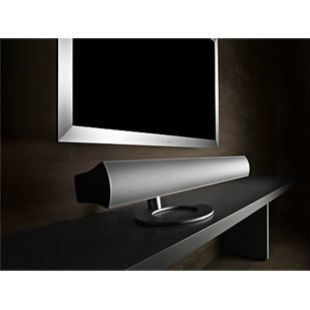
BeoLab 7-2
Packed with advanced technology, BeoLab 7 is, quite simply, the most powerful stereo speaker ever developed for TV. With six individual driver units, all powered by their own digital ICEpower amplifier, BeoLab 7 delivers an unequalled sound performance for your TV viewing. The beam-shaped loudspeaker below the screen provides superb acoustic performance and signifies the presence of sound as an integral part of your viewing experience. Musically, the speaker rivals many hi-fi systems, and is quite capable of being used as a BeoLink speaker.
The natural fit
BeoLab 7 is specially developed for BeoVision 7 to contribute the ultimate stereo sound performance to the viewing experience. BeoLab 7-1 is the natural accompaniment for the BeoVision 7-32 LCD television, while the broader beam of BeoLab 7-2 is designed for BeoVision 7-40. In addition, BeoLab 7 stereo loudspeakers fit naturally under the BeoVision 4 plasma screen, or under a projection screen. In this application, the speaker can be either wall-mounted or placed on a special tabletop stand.
Colours to match
Long and lean, BeoLab 7-1 and BeoLab 7-2 look at home under a BeoVision 7 or BeoVision 4, or as part of a projection screen setup. The shorter BeoLab 7-1 is best suited for the BeoVision 7-32” screen. The loudspeaker cabinet is made from a single piece of aluminium and coated in a resilient black soft-touch lacquer. The perforated aluminium front grill now comes anodised in five different colours: Light and dark grey, blue, red and black.
A firm grip on powerful sound
A special three-way bass reflex construction incorporates six individual units – two each for treble, mid-range and bass. Each driver is powered by a unique built-in ICEpower amplifier, delivering a combined effect of 750 watt. In addition, BeoLab 7-1 and 7-2 are equipped with thermal protection circuits and Adaptive Bass Linearisation (ABL), which ensures maximum performance without distortion, even at very high volume. Bang & Olufsen has a quarter of a century of experience making loudspeaker cabinets from extruded aluminium. This technique allows for very rigid and compact enclosures with powerful sound performance.
Note that BeoLab 7-1 was designed to be used with the BV4-37 and BV4-42. The wider BeoLab 7-2 may be used with the larger-version BeoVision 4: BV4-50 and BV4-65.
Mounting Options
All four versions of BeoLab 7 were designed for incorporation with Bang & Olufsen’s motor stand options.
BeoLab 7-2 Product Details
Type Numbers
Please let us know
Designer
Manufactured
2005 -
Colour Options
Black, Silver, Dark Grey, Red, Blue
BeoLab 7-2 Product Specification
Dimensions W x H x D / Weight 124 x 11 x 21 cm / 11 kg
Cabinet Finish
Black aluminium cabinet
Front grill: Black, silver, dark grey, red, blue
Power Consumption typical 20 W, standby 0.3 W
Power amplifiers 3 X 125 watts, Class D, iCEpower
Long-term Maximum output
Power Per Module 120 W/8 ohm per module
effective Frequency range 37 – 20,000 Hz
CABINET PRINCIPLE Bass: Bass Reflex – Midrange/Treble: Closed box.
Magnetic Leakage not shielded
Woofer 10.2 cm – 4″
Midrange 7.6 cm – 3″
tweeter 1.9 cm – 3/4″
room adaption – Free or Wall position
Cabinet Volume Bass: 5.2 litres Midrange: 0.8 litres per side
Bass equaliser – Adaptive Bass Linearisation (ABL)
CONNECTIONS: Power Link (one) Mains (one input, one output)
Gold or Silver membership required to view documents
Available documents are listed, if none are listed then please reach out to see if we have them.
BeoLab 7-2 FAQs
Please let us know
BeoLab 7-4
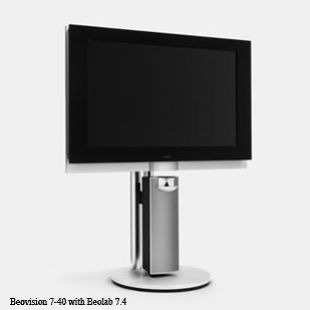
BeoLab 7-4
BeoLab 7-4 brings extra authenticity to any film or TV experience. Using the same acoustic lens technology found in BeoLab 5, this compact but powerful speaker is optimised specifically to reproduce the sound of voices. This is essential in a surround sound set-up, as eighty per cent of the voice information goes through the centre channel. Next time you watch a movie, you won’t miss a whisper.
Surround sound centrepiece
In a surround sound setup, BeoLab 7-4 is designed to give a powerful performance in the important centre channel. It can be used with all BeoLab loudspeakers and the BeoLab 2 subwoofer for the ultimate surround sound experience with the BeoVision 7-40 LCD or BeoVision 4 plasma televisions, or a projection screen. Moving with the motorised floor stand of your BeoVision 7, BeoLab 7-4 adds an extra dimension of sound to whatever you are watching on TV.
BeoLab 7-4 has a vertical construction that provides the best possible tonal balance found in speech. The deepest bass sounds are filtered out, ensuring greater power output and enabling BeoLab 7-4 to play up to the extreme capabilities of the BeoLab 5 loudspeaker. The acoustic lens, centred just beneath the screen as a visual emphasis of refinement, ensures an experience of tonal clarity in the horizontal plane. The sound of voices becomes extremely authentic, regardless of where you are seated.
Consistent lines and harmonious colours
The cabinet is coated in a durable yet silky black lacquer surface. Facing you is a front grill made out of anodised aluminium with a perforated pattern available in five different colours, giving a graphic touch to the overall look. As with all Bang & Olufsen products, there is always a consistency in the design lines, so you will quickly see a coherence between the curved DVD loader on BeoVision 7 and the curved front of BeoLab 7-4.
Mounting Options
All four versions of BeoLab 7 were designed for incorporation with Bang & Olufsen’s motor stand options.
BeoLab 7-4 Product Details
Type Numbers
Please let us know
Designer
Manufactured
2005 -
Colour Options
Black, Silver, Dark Grey, Red, Blue
BeoLab 7-4 Product Specification
Loudspeaker Two-way mono, active loudspeaker
Power consumption 12W, standby 0.3W
Acoustic Lens Technology – Yes
Amplifier units – Two 250W ICEPower units, one for each driver unit
Frequency range 50 – 20,000 Hz
Drive units 5” woofer/mid-range 3/4” treble
Thermal protection – On each unit
Adaptive Bass Linearisation – Yes
Gold or Silver membership required to view documents
Available documents are listed, if none are listed then please reach out to see if we have them.
BeoLab 7-4 FAQs
Please let us know
Master Control Link MCL30 & MCL82
Master Control Link MCL30 & MCL82
Type | Language | Type | Date | Type | |
User and Installation Manual | EN | 2050 | 03-85 | MCL30 User and Installation Manual |
Master Control Link (abbreviated MCL or Link) was a unit which made it possible to control and enjoy a music system from any room in the house that had a Link unit installed. It was operated by infra-red remote control.
The two systems – MCL30 and MCL82 were introduced in 1982. The ’82’ of MCL82 signified the year of its introduction. Both Link systems were predecessors to MCL2 (introduced in 1987) and MasterLink from the early 1990s.
Which Link system for which product?
| MCL 82, Type 2041 (1982 – Dec 1997) | MCL 30, Type 2050 (1982 – May 1993) |
| BeoCenter 7000 type 1801/1803/1808 BeoCenter 7002 type 1801 BeoCenter 7007 type 1821 – 1829 BeoCenter 7700 type 1811 – 1819 BeoMaster 5000 type 2321 – 2329 BeoMaster 8000 type 1901 – 1909 (each Link unit had to be modified in order to function) * | BeoMaster 3000 type 2931 – 2939 |
| * Master Control Link could not be connected to BeoMaster 8000 and 6000 directly because there was no connection for Datalink and supply voltage to the system through extra pins in the speaker sockets. Consequently, it had to be supplemented with an extra box, Type 1006/1007 (MCL-BeoLab kit), which was supplied with special mounting instructions. | |
Which Remote Control Units could be used?
This chart indicates which remote control units – Master Control Panel or Terminal – may be used in the Link room together with the various music systems:
Master Control Panels
| Music system | Remote control with display | Type | Order no: |
| BeoCenter 7700 | Master Control Panel 7700 | 2042 | 8920420 |
| BeoCenter 7007 | Master Control Panel 7700 (display operated through Master Control Link) | 2042 | 8020420 |
| BeoMaster 5000 | Master Control Panel 5000 | 2038 | 8920380 |
Terminals
| BeoCenter 7700 | BeoCenter Terminal | 2043 | 8920430 |
| BeoCenter 7007 | BeoCenter Terminal | 2043 | 8920430 |
| BeoMaster 5000 | Terminal 5000 | 2039 | 8920390 |
| BeoCenter 7000 – 7002 | BeoCenter Control Module | 8052115 | |
| BeoMaster 8000 | BeoLab Terminal | 1002 | 8052142 |
| BeoMaster 6000 | BeoMaster Terminal | 2035 | 8052139 |
| BeoMaster 6000 | BeoMaster Terminal | 2035 | 8052139 |
| BeoMaster 3000 | Terminal 3000 | 2044 | 8920440 |
Outline of the two Master Control Link Systems
The two Link systems consisted of two parts:
1. Transceiver (infra-red transmitter-receiver with some direct control buttons)
2. Relay box (containing control electronics and connections)

Dimensions 130 x 39 x 22mm

Dimensions: 160 x 110 x 35mm
The two parts were connected and, together with a set of speakers and a control cable, the parts constituted an extra “remote control terminal” for the music system. The control cable was an 8 mm cable run from the music system to the Link unit.
Extra rooms may be added on; all that was required was to install a Master Control Link and a set of speakers in each room and run a control cable from another Link or from a connection box.
The functions available on the music system remote control unit could be operated from Link rooms.
How did Master Control Link work?
The advantage of the Master Control Link is that it was possible to both operate and listen to music in another room. It was possible to listen to radio programmes, records and tapes, adjust volume and to switch the whole music system on and off from any room that had an MCL-unit installed. Operation was effected by means of the Master Control Panel or Terminal available for the music system (such as BeoSystem 5000).
The technical function of the Master Control Link was to pass a control signal to and from a BeoMaster or BeoCenter and to control switching of the speaker set connected.
MCL together with a music system with which a Master Control Panel could be used
When a Master Control Panel button was actuated, an infra-red signal was transmitted to the Transceiver which received the signal and transformed it into a digital code. This digital code was passed on through the relay box to the music system where the desired function was executed and confirmation that the function had been executed was sent back through the same lead. The Transceiver then fed back information to the Master Control Panel which indicated the function achieved on the display.
If the whole system was on stand-by and P1 was actuated on the Master Control Panel, then the following would happen:
- digital signals were transmitted through the Transceiver and the relay box to the Music System and started it on radio program 1
- digital signals were also passed to the microcomputer in the relay box and as the speakers were not switched on, this would be effected by the relay
If the next order concerned change of programme or a sound adjustment of the Music System the microcomputer checked the digital code prior to accepting it and passing it on to the Music System, and this is all that will happen in the relay box
The MUTE function, however, applied only to the room from which the system was being operated:
Only the speakers in this room were switched and the order was not passed on to the music system. A stand-by order from the Music System or from another Transceiver in a different room caused all speakers to be switched off.
After installation of a Master Control Link system with which a Master Control Panel was, testing had to be executed with the latter. This was in order to ensure that transmission both to and from the Music System was unimpeded. (Confirmation from the Music System is indicated on the Control Panel display.)
MCL together with music systems with which only Terminal could be used
When a switch on the Terminal is actuated an infra-red signal is transmitted to the Transceiver which receives the signal and transforms it into a digital code. This digital code is passed on through the relay box to the Music System where the desired function is executed.
Speaker control can only be carried out manually by pressing the speaker button on the Transceiver.
An exception to this is BeoCenter 7000/7002 where switching on is carried out automatically when operated with a Terminal, but switching off must be carried out by actuating the Transceiver speaker button.
What may be controlled from the Link room?
| Operation with MCP or Terminal | Music system: | |||||
| BeoCenter 7700 – 7007 | BeoMaster 5000 | BeoCenter 7002 – 7000 | BeoMaster 8000 | BeoMaster 3000 | BeoMaster 6000 | |
| What may be operated? | All MCP or Terminal functions (only speakers in room selected were coupled, provided that a Link was mounted in Center room | All MCP or Terminal functions. Only speakers in room selected were coupled | All Terminal functions | All BeoLab Terminal functions. Speakers had to be connected to Transceiver box with
|
All BeoMaster Terminal functions. Speakers had to be connected to Transceiver box with
|
All BeoMaster Terminal functions. Speakers had to be connected to Transceiver box with
|
| MUTE/MUTING | Speakers in this room were coupled or uncoupled | Speakers in this room were coupled or uncoupled | No MUTE button | No MUTE button | MUTE button worked when music system was on and for all speakers | MUTE button worked when music system was on and for all speakers |
| RESET | All speakers were adjusted to the pre-set volume | RESET of sound each time BeoMaster was switched on. No RESET button | RESET of sound each time BeoCenter was switched on. No RESET button | RESET of sound each time BeoMaster was switched on. No RESET button | RESET of sound each time BeoMaster was switched on. No RESET button | All speakers were adjusted to the pre-set volume |
| STATUS (MCP only) | Yes | Yes | ||||
| Display function (MCP only) | Yes | Yes | ||||
| Stand-by | Music system went stand-by. Speakers were uncoupled in all rooms | Music system went stand-by. Speakers were uncoupled in all rooms | Music system went stand-by. Speakers remained coupled and were played the next time system was switched on | Music system went stand-by. Speakers remained coupled and were played the next time system was switched on | Music system went stand-by. Speakers remained coupled and were played the next time system was switched on | Music system went stand-by. Speakers remained coupled and were played the next time system was switched on |
| * If the Link units were connected to the SPEAKERS 1 outputs on BeoMaster 3000 and headphones were connected, the sound in the Link rooms would disappear | ||||||
Operation from Transceiver
MCL82, Type 2041
| Operation on Transceiver box | Music system: | |||
| BeoCenter 7700 – 7007 | BeoMaster 5000 | BeoCenter 7000 – 7002 | BeoMaster 8000 | |
| Speakers in this room | Coupled or uncoupled speakers. Al speakers were adjusted to RESET level. May switch BeoMaster on last program selected | Coupled or uncoupled speakers. May switch BeoMaster on last program selected | Coupled or uncoupled speakers and ‘remembered’ last setting. Did not switch on BeoCenter; this had to be done via Terminal and speakers were coupled automatically | Coupled or uncoupled speakers and ‘remembered’ last setting. Did not switch on BeoCenter; this had to be done via Terminal |
| TIMER Used when music system was switched on by means of time programming | Button in = speakers will be on Button out = speakers will be off | Button in = speakers will be on Button out = speakers will be off | Button not operational. Speakers were coupled or uncoupled by
|
Button not operational. Speakers were coupled or uncoupled by
|
| Stand-by | Switched off whole music system except when recording | Switched off whole music system except when recording | Switched off whole music system except when recording | Button not operational |
MCL30, Type 2050

Speaker functions in Main Room
| Music system: | |||||
| BeoCenter 7700 – 7007 | BeoMaster 5000 | BeoCenter 7002 – 7007 | BeoMaster 6000/8000 | BeoMaster 3000 | |
| Coupling and uncoupling in same room as music system | SPEAKERS 1 button or automatic control through MCL in same room. TIMER button | MUTING button | SPEAKERS 1 button | SPEAKERS 1 button | SPEAKERS 2 button (only if Link units were connected to SPEAKERS 1 outputs) |
| Time programming for starting a program, speakers in same room were desired to be coupled | SPEAKERS 1 button or automatic control through MCL in same room. TIMER button | Connect phones or automatic control through MCL in same room, TIMER button | SPEAKERS 1 button | SPEAKERS 1 button | |
ML / MCL Product Compatibility
ML / MCL Product Compatibility
ML Compatibility - Audio Products
| BeoCenter 9000 – Has limitations. Not recommended | BeoSystem 3500 – Beolink Converter required | BeoVision LX2500/2800 – not compatible | BeoCenter AV9000 – Compatible |
| BeoCenter 8000 – no link connections | BeoSystem 4500 – Beolink Converter required | BeoVision LX2502/2802 Beolink Converter required (Limited use as main TV) | BeoVision Avant – Compatible |
| BeoCenter 2300 – Beolink Converter required | BeoSystem 5500 – Beolink Converter required | BeoVision MX3500/5500 – Beolink Converter required | BeoVision AV5 – Compatible |
| BeoCenter 2500 – Beolink Converter required | BeoSystem 5500 – Beolink Converter required | BeoVision LX4500/5500 – Beolink Converter required | BeoVision 3 – Compatible |
| BeoCenter 8500 Beolink Converter required | BeoSystem 7000 – Beolink Converter required | BeoVision MX 4000/6000/7000 – Beolink Converter required | BeoVision 5 – Compatible |
| BeoCenter 9300 – Beolink Converter required | BeoSound 2300/2500 – Beolink Converter required | BeoVision MX8000 – Compatible | BeoVision 1L – Compatible (Options 1 or 2) |
| BeoCenter 9500 – Beolink Converter required | BeoSound Ouverture/3000 – Compatible | BeoVision LX5000/6000 – Beolink Converter required | BeoVision 6 – Compatible |
| BeoSound 9000 – Compatible | BeoSound 3200 – Compatible | BeoVision AV9000 – Compatible | |
| BeoSound Century – Not compatible | BeoCenter 2 – Compatible | BeoVision 1 – Not compatible | |
| BeoSound 1 – Not compatible | BeoCenter 1 – Compatible (only with BC1 updated model: Options 1 or 2) |
ML Compatibility - Link-only Products
| BeoVision MX4002 – Compatible |
| BeoLab 2000 – Compatible |
| BeoLab 3500 – Compatible |
MCL Compatibility - Audio Products
| BeoCenter 9000 – may need Beolink SW | BeoSystem 3500 – compatible | BeoVision LX 2500/2800 – not compatible | BeoVision AV9000 – ML/MCL Converter required |
| BeoCenter 8000 – no link connection | BeoSystem 4500 – compatible | BeoVision LX 2502/2802 – Compatible | BeoVision Avant – ML/MCL Converter required |
| BeoCenter 2300 – needs ML/MCL Converter | BeoSystem 5500 -compatible | BeoVision MX3000/4500/5000 – Compatible with limitations | BeoVision AV5 ML/MCL Converter required |
| BeoCenter 2500 – needs ML/MCL Converter | BeoSystem 6500 – compatible | BeoVision MX3500/5500 – Compatible | |
| BeoCenter 8500 – compatible | BeoSystem 7000 – compatible | BeoVision LX4500/5500 – Compatible | |
| BeoCenter 9300 – compatible | BC Ouverture – needs ML/MCL Converter | BeoVision MX4000/6000/7000 – Compatible | |
| BeoCenter 9500 – compatible | BeoSound 9000 – needs ML/MCL Converter | BeoVision LX 5000/6000 – Compatible | |
| BeoSound Century – not compatible | BeoSound 1 – not compatible |
MCL Compatibility - Link only products
| BeoVision MX 4002 – Beolink Converter required (SW 1.3) | |
| BeoLab 2000 – Beolink Converter required (SW 1.3) | |
| BeoLab 3500 – Beolink Converter required (SW 1.3) – BeoLab 3500 works with both ML and MCL |
NOTE: for Software updates (SW) always consult your B&O dealer
BeoMaster 6000 (1974)
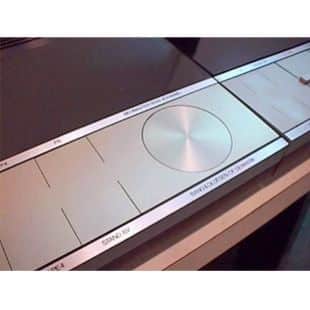
BeoMaster 6000 (1974)
A thoroughgoing ‘black box’. Nothing in the shape of the device revealed how it worked or what it was. Only the inscription on the top of the unit told the user just how the black ‘magic mirror’ was brought to life so it could show which function has been activated. The unit was Bang & Olufsen’s first remote-controlled hi-fi system.
Beomaster 6000 History
Beomaster 6000 was the realisation of the Topline prototype on which work had progressed over the preceding years. The long flat cabinet of the Beomaster 1200 with its operation from the top and the depressed knobs was repeated. But the Beomaster 6000 is the first representative of a new phase in Jacob Jensen’s oeuvre. The slide rule motif symbolised mechanical precision, but now the entire idiom is adapted to the abstraction it was necessary to submit in communicating using electronics. The visually, symbolically and tactilely easily understood slide rule operation belonged to the age of mechanisation and must be understood in extension of the modernistic machine aesthetics of the 1920s. The design of the Beomaster 6000 emphasises that it belongs to the electronic age and that it is part of the virtual, digital epoch. The volume is regulated stepwise by pressing one button to increase volume and another to reduce it. The buttons are gathered together in one large steel sheet, in which ‘tongues’ have been cut. These each have a play of less than half a millimetre as they are electronic micro-switches. The depressed adjustment knob, which made its first appearance in the General Electric radiogram study model around 1960, is an electronic tuner. ” The great quality of the slide rule motif was that it showed both the user’s input (setting) and the device’s output at the same time. The logical consequence of micro-electricity is a division of input and output – the electronics differ from mechanical operation in that their function is invisible. Jensen does what he can, nevertheless, to make it easy to understand what is happening. Input is placed in a silver-coloured control panel, while output (displays) is gathered under a sheet of dark glass. This magical black sheet, ‘the magic mirror’ that lights up while in use, is to give an extra experience over and above the purely aesthetical. The Beomaster 6000 is a very easy advanced quadraphonic radio. In view of the development team, four sound channels required your being able to adapt the sound to your position in the room. In this way, the first remote-controlled hi-fi system became a reality. ” – taken from ‘Jacob Jensen’ by Christain Holmsted Olesen.Beomaster 6000 features
At the centre of the Beosystem 6000 was Beomaster 6000, a 4-channel amplifier with an FM tuner. Beomaster 6000 had a built-in SQ decoder (4-channel matrix) and was a full remote controlled system. Five FM stations could be pre-selected and there was manual tuning on the large illuminated FM scale. The FM tuner covered 87,5 – 104MHz. Tuning was carried out via feather-touch controls. The amplifier section was designed to cope with all sound reproduction systems: one, two or four channels. It produced 4×40 watts RMS (4 ohms) or 300 watts total music. 4-channel sound reproduction from records was popularly represented by two systems: CD4 discrete and SQ matrix. CD4 (Compatible Discrete 4 channel) enabled high-quality sound reproduction with a high degree of separation between the four channels. CD4 was called at the time ‘TRUE 4 channel system’. However, many companies chose the SQ system because it was easily transmitted over FM and SQ records could be played on a high quality stereo record player. However, the price of convenience was less channel separation than the CD4 system afforded. An SQ matrix decoder was incorporated in Beomaster 6000. Basically, its job was to reconstruct sound information for the two rear speakers. For CD4 records this reconstruction took place in the record-player, Beogram 6000.Operation
Operation of Beomaster 6000 was child’s play. The large flat operation panel had logically grouped controls for all essential functions. Primary functions (e.g. programme source selection, volume, balance, bass and treble controls) were large, prominent, yet unobtrusive easy-touch buttons, while secondary functions (e.g. loudness, hi and low filters, etc) were smaller push buttons. Volume, balance, bass and treble controls were executed by a feather-touch of the finger tip. A servo-motor did the real work. An illuminated scale indicated position and control levels. There were facilities for frequency correction on all 4 channels. Each channel had a frequency range of 20-30,000 Hz. Distortion was lower than 0.1% at full power output.Remote Control
The cordless (ultrasonic) remote control for the receiver could be bought as an accessory. This unit put you in true control of the music system. All the following functions could be controlled: volume, balance: left and right speakers; balance: front and rear speakers; five pre-selected FM stations; selection of external programme sources: record-player, tape/cassette-recorder; switching on and off (stand-by).Connections
All necessary connection facilities were incorporated in Beomaster 6000: 4-channel record player, 2 or 4-channel tape-recorder. 4-channel headphones or two sets stereo headphones. Beomaster 6000 was perfectly matched to partner the Beocord 5000 cassette recorder (introduced 1975). Beomaster 6000 was featured in an exhibition at New York’s MoMA (Museum of Modern Art) in 1975. At the time of its release it was the flagship of Bang & Olufsen’s hi-fi product range and was quite expensive to purchase. The UK price in 1978 was £581.50.Accessories:
FM room aerial An FM aerial type 8902010, was designed for use with Beomaster 6000 to be used in the home, within a certain radius of the radio transmitter. It was easily positioned at the rear of Beomaster 6000 and its two telescopic elements could be extended.BeoMaster 6000 (1974) Product Details
Type Numbers
2702
Designer
Manufactured
1974 – 1977
Colour Options
Rosewood, Teak, White
BeoMaster 6000 (1974) Product Specification
Power output 1000 Hz RMS: 4 x 40 watts / 4 ohms, 4 x 30 watts / 8 ohms
Music power: 4 x 75 watts / 4 ohms, 4 x 40 watts / 8 ohms
Speaker impedance: 4 ohms
Harmonic distortion: < 0.06 %
Frequency range: 20 – 30,000 Hz
Bass control: +/- 17 dB
Treble control: +/- 14 dB
FM range: 87.5 – 104 MHz
Power supply: 110 – 130 – 220 – 240 V
Power consumption: 10 – 350 watts
Dimensions W x H x D: 67 x 8 x 32 cm
Weight: 16 kg
Connections: AUX , Phono, tape (front)
Batteries for your BM6000 Commander Remote Control:
• Duracell: M504
• Eveready: 504, ER-504
• Gold Peak: GP220
• I.E.C.: 10F15
• NEDA: 504M, 220
• Panasonic: W10, W10E
• Polaroid: 202, 222
• RadioShack: 01386, 0400125, 22049, 22205, 23-509
• Varta: V74PX IEC 10 LR54
• Vinnic: 10LR54
Gold or Silver membership required to view documents
Available documents are listed, if none are listed then please reach out to see if we have them.
BeoMaster 6000 (1974) FAQs
Please let us know
BeoVox Penta
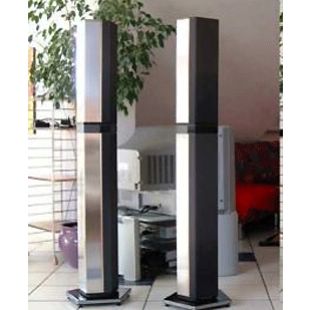
BeoVox Penta
Smaller, but perfectly formed
For rooms where you didn’t need so much power, Beovox Penta was the little brother which suited you down to the ground. It didn’t have the built-in amplifier or the light display, but it was identical to BeoLab in all other respects.
BeoVox Penta Product Details
Type Numbers
6611 (1986 – Dec 1992)
Designer
Manufactured
1986 – 1992
Colour Options
Silver
BeoVox Penta Product Specification
RMS power handling capacity 150 watts
Music power handling capacity 200 watts
Impedance 8 ohms
Frequency range 4+ -8 dB 40 – 20,000 Hz
Power at 96 dB SPL 2.5 watts
Sensitivity 1 W 92 dB
Distortion 250 – 1000 Hz
<0.5%
Distortion > 1000 Hz <0.5%
Cabinet principle: Bass reflex
Woofer: 4 units 13 cm
Mid-range: 4 units 8 cm
Tweeter: 2.5 cm
Net volume: 32 litre
Gold or Silver membership required to view documents
Available documents are listed, if none are listed then please reach out to see if we have them.
Type | Language | Type | |
Service Manual | EN | BeoVox Penta Service Manual |
BeoVox Penta FAQs
Please let us know
Wiring Diagrams
Wiring Diagrams
All wiring diagrams to plugs and sockets are shown from the soldering side.
MasterLink cable
Note: For older-type ML cable, the colour coding is slightly different. This image refers to current ML cable.
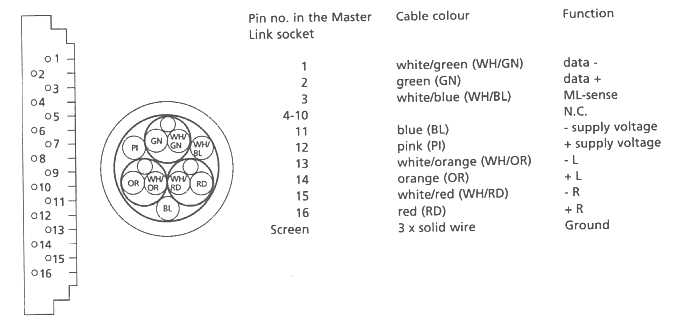
Master Control Link cable

DataLink Cable 7/7 pin A/V Cable
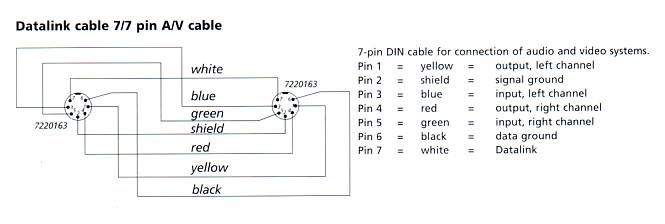
21-pin A/V cable with RGB connection:
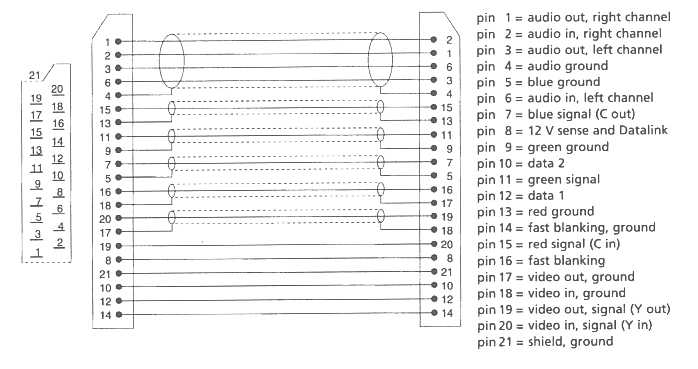
Receiver cable
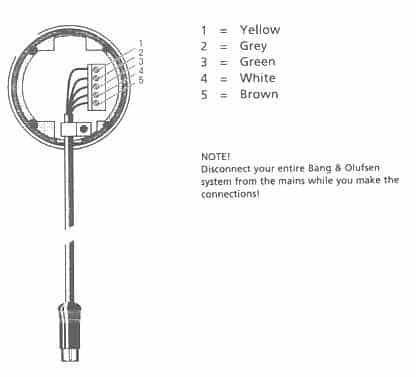
Infra-red eye wiring
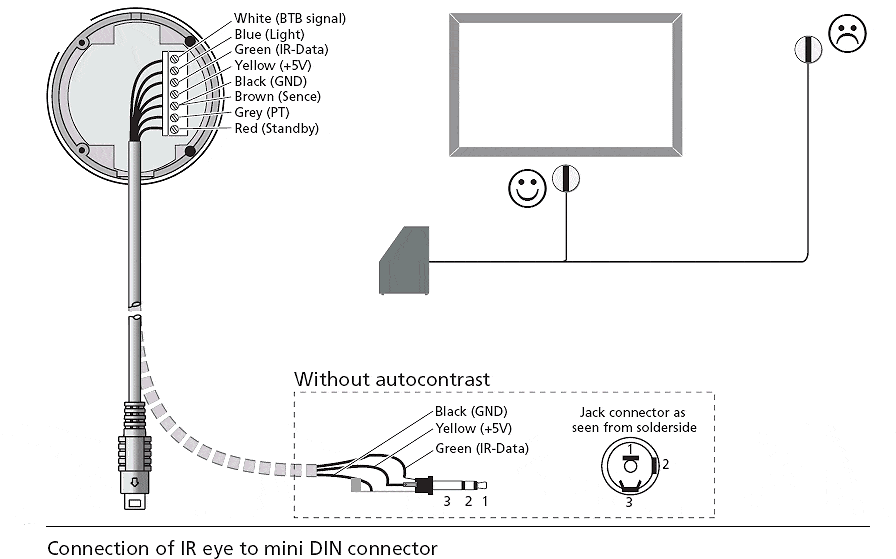
Headphones

B&O Motorised Stand

Note that the technical specifications for the motorised stand changed from Product ref. MX6/7 to MX8. Newer models also have a different stand connection
RGBHV Cable (15-Pin D-SUB)

15-Pin D-SUB

Power Link cable with wire for display, also for BeoLab 5

Power Link cable 8/8 pin
(Note: On BeoLab3 there is a blue wire (pin 7) in addition to the wires shown here on the PowerLink diagram. This appears to be a voltage reference for the speakers, and with a single three core wire + screen feeding both speakers, this needs to be connected to the screen.
Failure to connect this pin does not have too much of an effect on the system -UNLESS- you connect up something like a PC2 which ties the stereo to Earth potential through the MasterLink cable, and without the “blue reference” the speaker inputs can float to around 100V above Earth and cause interference between the speakers and the 3000, manifesting as a quiet buzzing noise in the Lab3s. (I rather suspect there was actually an impact on sound quality from no Blue connection but cannot measure it) – Stephen Lewis)

Power Link cable

Speaker Link cable

Audio Aux Link / Power Link connections
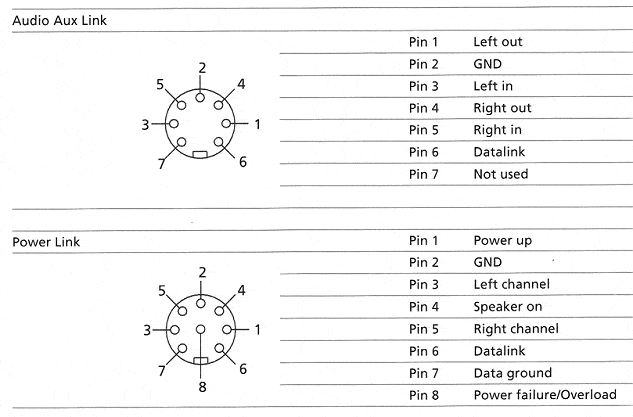
Aux Link cable
| white | data |
| blue | left channel input |
| green | right channel input |
| shield | ground |
| red | right channel output |
| yellow | left channel output |
| black | data ground |
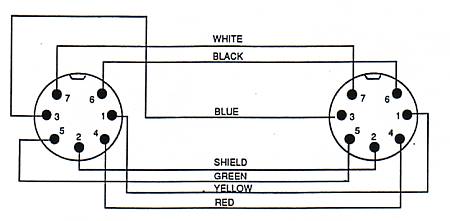
male to male, using unterminated cable number 6250265 and plug number 7220688 or 7220701. For connection between video system and audio system. Maximum length: 100m
Aux Link/Datalink cable
| white | data |
| blue | left channel input |
| green | right channel input |
| shield | ground |
| red | right channel output |
| yellow | left channel output |
| black | data ground |
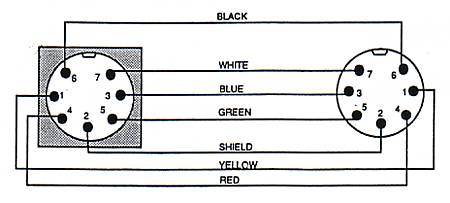
male plug to wall plate, using unterminated cable number 6250265. Use male plug number 7220688 or 7220701 and an 8-pin wall plate number 7210473. Used for connecting local sources when MCL 2AV is concealed
Aux Link Wall Plate
| Audio System | Video System | |
| white | data | data |
| blue | left channel input | left channel output |
| green | right channel input | right channel output |
| shield | ground | ground |
| red | right channel output | right channel input |
| yellow | left channel output | left channel ground |
| black | data ground | data ground |
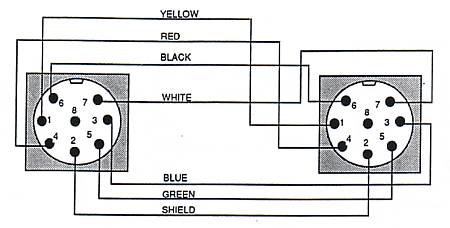
wall plate to wall plate, using unterminated cable number 6250265 and two 8-pin wall plates number 7210473. Used for connection between audio and video systems within the wall wiring
Switch for deactivation of MCL
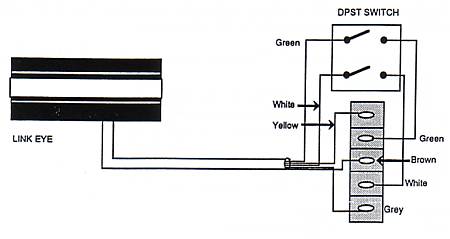
Audio Aux Link
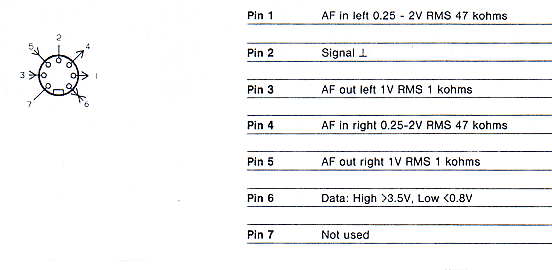
MCL cable from audio systems to terminal
| green | right channel hot |
| brown | right channel ground |
| pink | DC supply 7.5 – 8.5 VDC |
| yellow | left channel hot |
| grey | left channel ground |
| white | data |
| shield | data and ground DC ground |
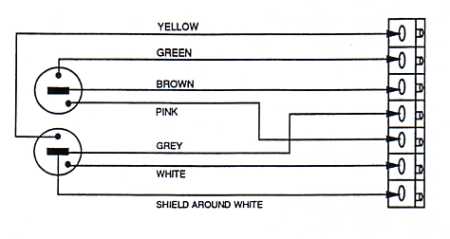
MCL cable from audio systems to terminal strip in MCL2 relay box. NOTE: Use pre-made MCL cables for connection to the audio system whenever possible
MCL cable, 2 x 3-pin MCL to 8-pin DIN plug
| green | right channel hot |
| grey | left channel ground |
| white | data |
| shield | data and DC ground |
| brown | right channel ground |
| pink | DC supply 7.5 – 8.5 VDC |
| yellow | left channel hot |
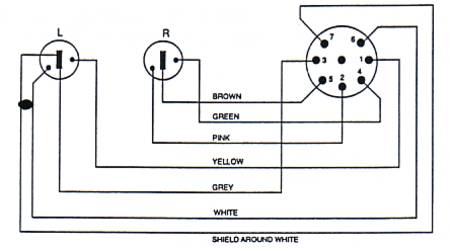
MCL cable, 2 x 3-pin MCL to 8-pin DIN plug. For connection between audio systems and link system via an 8-pin wall plate. Use pre-made MCL cable for connection to the audio system if at all possible
MCL cable between 8-pin DIN wall plate
| green | right channel hot |
| brown | right channel ground |
| pink | DC supply 7.5 – 8.5 VDC |
| yellow | left channel hot |
| grey | left channel ground |
| white | data |
| shield | data and DC ground |
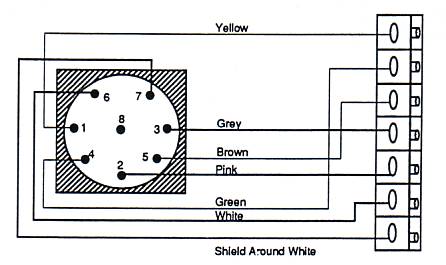
MCL cable between 8-pin DIN wall plate and MCL terminal strip. For connection between audio system and link system via an 8-pin wall plate
Speaker link cable from audio system or MCL to 4-pin wall plate
| green or brown | signal hot |
| shield | signal ground |
| white | display data |
| shield | data ground |

Speaker link cable from audio system or MCL to 4-pin wall plate using speaker plug number 7220040. Use unterminated link cable number 6250246 or 6250267
PowerLink cable, male to male
| brown | left audio signal |
| green | right audio signal |
| shield: brown/green | left/right ground |
| grey | on/off |
| yellow | on/off |
| pink | APHC |
| white | data |
| shield: white | data ground |

PowerLink cable, male to male, using unterminated cable number 6250277 and plug number 7220345. Maximum length 100m
PowerLink cable, male to female (extension)
| brown | |
| green | |
| shield: brown/green | |
| grey | |
| yellow | |
| pink | |
| white | |
| shield: white |

PowerLink cable, male to female (extension) using unterminated cable number 6250277, male 8-pin plug number 7220345 and female 8-pin plug number 7220235 or 8-pin DIN wall plate number 7210473. Maximum length component to component: 100m
PowerLink cable, female to female
| brown | |
| green | |
| shield: brown/green | |
| grey | |
| yellow | |
| pink | |
| white | |
| shield: white |

PowerLink cable, female to female, using unterminated cable number 6250277 and two female 8-pin DIN plugs number 7220235 or two 8-pin DIN wall plates number 7210473
PowerLink 1 & 2

Using a non-B&O sub-woofer

his circuit is designed to use a non-B&O sub-woofer or amplifier with PowerLink sockets.
It’s easy to built and at low cost. In fact that the 5 V DC from the PowerLink socket on pen 4 can’t activate a relay directly you will need a circuit like this.
Parts which I’ve used are easy to buy at electronic shops. You need in total:
1 AC/DC Adaptor 12 V DC
1 IC LM 7806
2 Caps 100Nf 63V
1 Diode 1N4148
1 Resistor 2K2
1 Transistor BC 338
1 Relay 6V DC
Connection of the circuit is as follows:
Connect the adaptor to the 12V and earth of the circuit, connect pin 4 from the PowerLink to the 5V DC PowerLink in of the circuit. When switching on the B&O the relays will switch and connect the 230V AC line into the amp you use. That’s it. For heavy amps you can let the relay switch on a second heavy-duty relay, which will switch on the power line.
BeoLab Penta

BeoLab Penta
These tall and elegant speakers were developed according to a totally new acoustic principle. They sounded just as magnificent as they looked. Because there were no parallel surfaces in the pentagonal cabinet, the design reduced the internal standing waves and reflection; it was a simple and beautifully effective way of eliminating distortion. The cabinet provided the ideal conditions for the loudspeakers. It was an acoustically ‘dead’ construction, with a moulded inner cabinet surrounded by a stainless steel exterior. Whatever the dimensions of your room, and regardless of the furnishings, BeoLab Penta always sounded wonderful. It also needed very little floor space; head room was all that’s required!
BeoLab Penta was the top-of-the-line speaker from Bang & Olufsen. It was around from the late ‘eighties to the mid-1990s and was upgraded several times. The last version of the active Penta was the Penta 3. In the late 1980’s – when the Penta range was introduced – there was also a passive version, Beovox Penta. But since Bang & Olufsen decided in the 1990s just to concentrate on active speakers, these and some other models, such as the Beovox 4500 and most of the RedLine speakers, were discontinued.
Did you know that the display in Penta I and Penta II was orange and and on Penta III it turned green?
Why build amplifiers into the loudspeakers instead of keeping them separate?
Because you can reduce the size of the cabinet volume to one-third of the size of a conventional loudspeaker with the same sound capacity.
The principle is called Active Loudspeakers, and what you get is a compact loudspeaker that can play at high volume without distortion or damage to its drive units. Furthermore, when amplifier, treble and bass units are paired for the same task, they can be tailored to compensate for each other’s shortcomings. What you hear is music that sounds exactly like the instrument it originally came from.
BeoLab Penta had nine individual loudspeaker units that were accurately positioned in a vertical line to produce a sound dispersion which was so precise that reflections from the floor and ceiling were eliminated. Consequently, Penta speakers could be placed almost anywhere in a room, irrespective of its size or furnishings. The operating panel at the base of BeoLab Penta allowed for the fine tuning of the bass reproduction at three levels.
The speaker’s cross section was a pentagon. The benefit of this design was that it cannot house standing waves which normally are a problem in speakers. The choice of using polished stainless steel was made to help the speaker blend into its surroundings by reflecting them. This gave the speaker the same colour as the surroundings which helped to make the speaker more of a subtle fixture,
Sound with as many facets as a diamond
The location of the speakers within the column was carefully planned to control the sound waves so that they weren’t reflected by the floor and ceiling. The resulting sound quality simply beggared description.
BeoLab 150: Controlled overdrive
At the base of BeoLab Penta was the BeoLab 150 amplifier with a power output of 175 watts DIN/IEC. This could give your music a tremendous boost, both to the quality and the actual power output. It was ideal if you love partying but had a relatively small music system. Big power needs careful control – so the amplifier was equipped with Dynamic Soft Clipping system. When there was any overloading, the system softly rounded off the sound; distortion becoming a thing of the past.
Speakers that more than measure up
Top quality music systems need the best speakers available – or you’re missing out. BeoLab Penta was the natural partner for Bang & Olufsen’s Beosystem 5000 and Beocenter 9000, with their built in CD players. The laser-pure quality of compact disc makes heavy demands on speakers, and both these systems had extremely fine amplifiers. Using BeoLab Penta with these systems and you’d enjoy some of the best sounds in the world. You’d also appreciate handy features such as the light display at the base of the column, which indicated which music source was being used. Of course this was even more useful if you installed Beolink® to give you music all over the house.
BeoLab Penta Product Details
Type Numbers
Beolab Penta 1
6601 1986 05-89
6605 (AUS) 1986 10-89
6602 (GB) 1986 10-89
6604 (J) 1986 11-89
6603 (USA) 1986 11-89
Beolab Penta 2
6621 1989 05-92
6625 (AUS) 1989 09-91
6622 (GB) 1989 10-91
6624 (J) 1989 01-92
6623 (USA) 1989 12-91
Beolab Penta 3
6631 1991 05-2000
6635 (AUS) 1991 05-2000
6632 (GB) 1991 05-2000
6634 (J) 1991 05-2000
6633 (USA) 1991 05-2000
Designer
Manufactured
1986 – 2000
Colour Options
Aluminium/Grey
BeoLab Penta Product Specification
Beolab Penta 1
RMS power handling capacity 150 watts
Music power handling capacity 200 watts
Frequency range +4 -8 dB 40 – 20,000 Hz
Power at 96 dB SPL 2.5 watts
Sensitivity 92 dB
Distortion 250 – 1000 Hz <0.5%
Distortion >1000 Hz <0.5%
Cabinet principle: Bass reflex
Woofer
4 units 13 cm
Mid-range 4 units 8 cm
Tweeter 2.5
Net cabinet volume: 32 litres
Power amplifier:
Bass level switch Linear, +3 dB/40 Hz, +6 dB/40 Hz
Sensitivity 3 dB, -3 dB, -6 dB
Power supply
6601 : 220V
6602/6605 : 240V
6603 : 120V
6604 : 100V
Power frequency 50-60 Hz
Power consumption Max 300 W
Stand-by 2 W
Dimensions W x H x D
5-13.5 x 165 cm incl. stand
Weight 24 kg
Connections: Line Phono plugs
Power input 4-pin DIN spring loaded contacts
Beolab Penta 2
Long-term maximum power IEC 320 watts
Maximum noise power IEC 150 watts
Impedance
8 ohms
Frequency range +4/-8 dB
40 – 20,000 Hz
Power at 96 dB SPL (1m)
2.5 watts
Sensitivity 1 W (1m) 92 dB
Distortion 0.250 – 6 kHz <0.5%
Cabinet principle: Bass Reflex
Woofer: 4 units 13 cm
Mid-range: 4 units 8 cm
Tweeter: 2.5 cm
Net cabinet volume:32 litres
Power amplifier:
Long-term maximum power IEC 300 watts
RMS DIN 175 watts
IHF 150 watts
Total harmonic distortion IHF <0.015%
Intermodulation IHF <0.02%
Dynamic headroom >1.5 dB
BASS EXTENSION switch
0 dB, + 3 dB, + 6 dB
INPUT LEVEL switch 0 dB, -3 dB, – 6 dB
Dynamic Clipping Attenuator Automatic
Power consumption
Max. 300 W
Stand-by 2 W
Dimensions W x H x D
22 x 165 x 20.5cm
Dimensions, stand 35.5 x 4 x 34 cm
Weight 24 kg
Connections: Power Link
Speaker Link
Beolab Penta 3
Dimensions W x H x D/Weight: 22 x 165 x 34cm / 12kg
Cabinet finish: Stainless steel
Power consumption
Typical 24 watts/stand-by < 2.5 watts
Mains 6630 KOR 120V
6631 EU 230V
6632 GB 230V
6633 USA-CDN 120V
6634 J 100V
6635 AUS 240V
Maximum sound pressure level (stereo, pair)
103 dB
Power amplifier modules 1 unit
Long-term maximum output power per module* 281 watts
Effective frequency range* 39 – 20,000 Hz
Cabinet principle Bass Reflex
Magnetic shielded No
Woofer 4 x 13 cm
Midrange 4 x 8 cm
Tweeter 2.5 cm
Net volume 32 litres
Bass equalizer Switch 0 dB, -3 dB, +6 dB
*According to IEC 268-3 and 268-5
Connections: Power Link 2
Phono (line) 1
Speaker Link
Gold or Silver membership required to view documents
Available documents are listed, if none are listed then please reach out to see if we have them.
Type | Language | Type | |
User Guide | EN | BeoLab Penta User Guide | |
User Guide | EN | BeoLab Penta User Guide | |
User Guide | EN | BeoLab Penta User Guide | |
Service Manual | EN | BeoLab Penta Service Manual | |
Service Manual | EN | BeoLab Penta Service Manual | |
Service Manual | EN | BeoLab Penta Service Manual |
BeoLab Penta FAQs
Please let us know
BeoLab 8002

BeoLab 8002
An update of the long running Beolab 8000, the Beolab 8002 introduced new drive units powered by a pair of ICE amplifiers rated at 125W each.B&O themselves commented that sound quality was unchanged and so this can be seen as a rationalising of the range rather than a radical overhaul of a much loved icon.
The mode LED was repositioned, but otherwise it seemed business as usual. A three way switch for room positioning was now included at the expense of the phono socket previously fitted. As before, only one Powerlink socket was provided.
BeoLab 8002 Product Details
Type Numbers
Please let us know
Designer
Manufactured
2010 -
Colour Options
Polished Aluminium
BeoLab 8002 Product Specification
Cabinet/Cover:
Black/black, dark grey/dark grey, red/black, blue/black,
silver/black, silver/white, golden/black
POWER CONSUMPTION
Typical: 19 W; Networked standby: 0.4 W
LONG-TERM MAXIMUM OUTPUT
POWER AMPLIFIER, BASS
125 W, Class D, ICEpower
POWER AMPLIFIER, TWEETER
125 W, Class D, ICEpower
EFFECTIVE FREQUENCY RANGE*
48-28,000 Hz
SENSITIVITY**
88 dB SPL re 125 mVrms re 1m
CABINET PRINCIPLE
Bass reflex
CABINET VOLUME
5.3 litres
BASS DRIVER
2 x 4″ cone
TWEETER
¾” dome
Adaptive Bass Linearisation (ABL)
Room adaptation
Thermal protection
CONNECTIONS
1 x PowerLink
Line in via PowerLink
ACCESSORIES
Wall bracket, black
Stand, black
Cover
ROOM ADAPTATION
Free, Wall or Corner position
MAGNETICALLY SHIELDED
No. Must be placed > 50 cm from picture tube
INPUT SENSITIVITY (POWER LINK)
125 mV (88dB SPL)
INPUT SENSITIVITY (LINE)
125 mV (88dB SPL) – Auto switch on
SWITCH-OFF TIME (LINE)
3 min.
INDICATOR
On/Off LED
OPERATION
Switch for Free, Wall, Corner
Switch for Left – Right – Line (via PL plug)
PROTECTION
Thermal protection of all drivers.
ABL system protects the bass unit against mechanical damage.
POWER SUPPLY
Automatic voltage adaptation 100-120 Vac or 190-240 Vac
MEASUREMENT CONDITIONS:
*EFFECTIVE FREQUENCY RANGE is measured at -10 dB re. Ref level (200-2000 Hz)
**SENSITIVITY is measured at dB SPL 1m re 125 mV
Gold or Silver membership required to view documents
Available documents are listed, if none are listed then please reach out to see if we have them.
BeoLab 8002 FAQs
Please let us know






